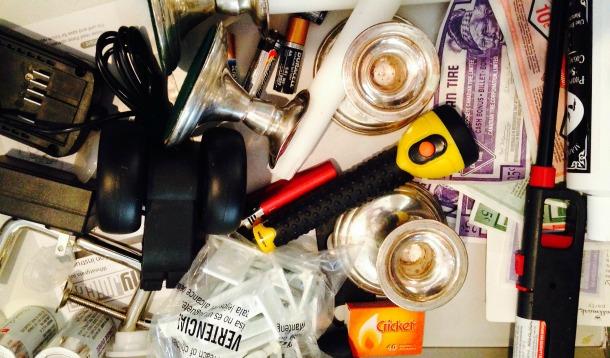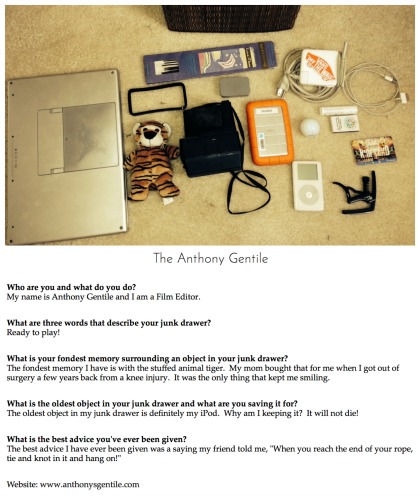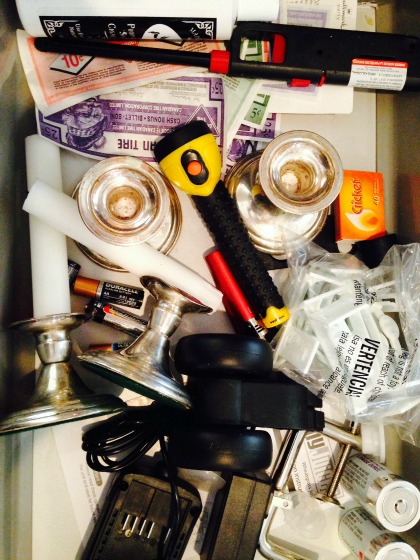
You and me, baby, ain’t nothing but mammals.
Some pregnant mammals prepare for their newborn by seeking the lowest spot of shelter. Others pace, hoard, or literally build nests. We humans clean, purge, scrub, alphabetize, and label.
It’s a powerful instinct, driven by hormonal forces deep in our primordial brains.
Thankfully, we’re slightly more cognizant than our monkey cousins, so can choose how we want to direct these instinctual pre-birth efforts. I, for one, will not be he building a nest of straw and grass lined with hair plucked from my body (this is the rabbit nesting ritual, apparently) before my due-any-day baby is born. I’ve got a list, and so should you.
So, how can you keep your eye on the prize in the final pre-baby months?
1. Don’t wait for month number eight:
While science tracks the nesting instinct at between months five and eight, you won’t want to wait until you are a waddling, exhausted, ball of anxiety before you tackle your to-do list. Don’t wait for hormones to dictate your plan. Starting a solid to-do list during your fifth month gives you enough time to complete any mid-sized projects (like painting).
2. Make your space more “helper” friendly:
Motherhood does not mean martyrdom, and help is not a dirty word. Some of your nesting activities should be focused on making it easier for others to help you. This could include:
Organize your life so that you can run things smoothly by giving instructions from the comfort of your nursing chair. You will thank yourself later.
3. Create “stations”:
Give yourself several baby changing, baby napping, nursing/feeding, and baby activity stations throughout your home. If your house has more than one floor, you will want to have changing, napping, nursing/feeding, and activity stations on each floor.
A “station” doesn’t need to mean more than a decorative basket stocked with diapers, wipes, a change mat, and garbage bags.
4. Keep projects achievable:
Now is not the time to add that second story. Keep your nesting projects achievable. You might have been given a “due date” by the doctor, but babies come when they are ready—even if you are not.
5. Stockpile the essentials:
This is your chance to really enjoy shopping in bulk. Important items to stock up on include:
There will be plenty of items you’ll need last minute . . . don’t make toilet paper one of them.
6. Grooming is giving:
In the delivery room, and in the weeks after baby is born, sometimes the only thing you find yourself wearing is your recent mani pedi. Take some time for you, as a gift to “future, naked you.”
This post on ladyscaping may help you decide whether to groom or not to groom.
7. Take time for love:
While putting your relationship on a to-do list doesn’t sound sexy or spontaneous, it is so important. Make a point of going on dates, snuggling, talking, listening, and just being together. This precious time will go a long way when sleep exhaustion starts jumping on your last nerve with one another.
8. Check your calendar:
While hard to believe, life does go on after labour. Birthdays, holidays, and other important dates will soon be upon you. Take time now to buy any cards and presents for these fetes.
9. Clutter trumps clean:
So you think you’re in early labour? So exciting! What’s the final thing you should accomplish from your nesting to-do list? Put away the clutter.
It is much more important to put away the clutter than it is to actually clean your house. Why? Because your visitors over the next few weeks will be more than capable of Windexing your coffee table, however they probably don’t know where to put your odds and ends. Experts say to distract yourself in early labour, and this is the perfect way to accomplish just that.
10. Get serious about sleep
Do not let your nesting instinct get in the way of getting some serious rest. No amount of planning, cleaning, and organizing can replace the benefits of a well rested you.
Make sure your partner or family is part of the nesting preparations! The four-square to-do list means you won’t have to go it alone.
Motherhood does not mean martyrdom. Don’t forget that Help is Not a Dirty Word!

“The contents of a junk drawer are a historic cache of information about a person. They raise questions about what makes us happy, what objects hold sentimental value and what makes us who we are—much like a time capsule or a scrapbook.”- The Junk Drawer Project
I’m obsessed with drawers right now. Not the sexy kind. I’m talking about junk drawers.
I’ve stumbled onto The Junk Drawer Project. This neat little art-slash-pseudo-psychological site takes a look at the junk drawers of random people. These folks have submitted photos of their junk, and then answered the following questions:
Who are you and what do you do?
What are three words that describe your junk drawer?
What is your fondest memory surrounding an object in your junk drawer?
What is the oldest object in your junk drawer and what are you saving it for?
What is the best advice you've ever been given?
Here are a couple of samples from the The Junk Drawer Project.


So...what did you learn about these folks? Do we think their junk drawers are a “time capsule” or authentic peek into their lives? Have you really learned something about these people?
This is my junk drawer

What does it say about me? Absolutely nothing.
This is my random crap that doesn’t file neatly into any other drawer, box, shelf, bag, or file. It says that I am storing too many used batteries for recycling, and that I can’t find a reason to get rid of the $1.45 I have in Canadian Tire money.
If the Junk Drawer Project were to really dig down on the psychology of the drawer, the more telling questions to ask would be:
Why are these items in here?
If the answer is “because they don’t fall into other drawer categories,” great. It sounds like you’re probably an organized person with a place for most of your other junk.
If you’re answer is “because I haven’t put this stuff away or thrown it out yet” you need to take some de-cluttering action in this drawer.
If the Queen [sub Ryan Gosling, Drake, Oprah, etc.] came over, would you be embarrassed to show them this drawer?
If the answer is “nah. It’s a harmless drawer devoid of X-rated weirdness or rat-infested garbage” great. Sounds like this drawer tells me you’re either organized or without the ability to be shamed.
If you’re answer is “yes! So embarrassing” then you * might * need to take some de-cluttering action here…
What would be the first thing from this drawer you would throw in the garbage?
Here’s where we really learn about the real you. Nah, that’s sarcasm. Just pick something from the drawer and throw it out. You’ll feel better for having lightened your hoarding guilt.
What would be the last thing from this drawer you would throw in the garbage? Why?
This is the most interesting question to ask about your junk drawer. Frankly, this might say the most about who you are, what you hold sacred, what items have meaning or utility in the kind of life you want to live.
My challenge to you is this: Answer those questions about your own junk drawer. Better yet, start to live a little lighter and clean that junk drawer out today.
If you want scientific guidelines for keeping a good junk drawer, check out this post called How to Make the Most of Your Weird Little Brain.
If junk just ain’t your bag, then help control it by using a Crap Basket.

“We must consciously look at areas of our lives that need cleaning up, and then methodically and proactively do so. And then keep doing it.” - Daniel Levitin, The Organized Mind
We take in five times as much information today as we did in 1986. In this age of information overload, it’s critical that we build and organize our lives to work with our human brains, so that we can reduce the burden on our minds and lives.
![]() Are You Smarter Than A Kid From 1912?
Are You Smarter Than A Kid From 1912?
A few weeks ago, I had the pleasure of hearing author and behavioral neuroscientist, Daniel Levitin, speak about his new book, The Organized Mind: Thinking Straight in the Ago of Information Overload.

Levitin’s background is impressive.

In short: this man knows brains. How they work. What they do. How we use them to our advantage and, more importantly, how we’re limiting our own productivity in this age of “information overload.”
I can’t even begin to summarize a single wisdom nugget from this incredible book, so here are some of the highlights that will blow your overloaded mind, and help you make the most of your weird little brain:
We may think we are successfully multitasking when we’re juggling our smartphones, our kids’ questions, and answering the phone, but science says we are still only shifting back and forth from one task to another very quickly. A switch from one task to another burns up glucose, releases stress hormones, and takes time between the task-switching. It short, multitasking is hurting your productivity.
Levitin gave a great example of task-focusing from his own life—he has set up an auto-email message that says, "I only check email twice a day. If this is urgent, please call my mobile." Try it.
The book suggests that one method for further breaking your to-do lists into easily actionable categories is:
1. Do it
2. Delegate it
3. Defer it
4. Drop it
It’s a helpful way of breaking our, often lengthy, to-do lists into more manageable pieces (as well as getting rid of non-essential tasks).
If you can attend to one of the “do it” items on your list in less than two minutes, do it now. Alternatively, a daily thirty-minute block is a good way to deal with small tasks quickly so they don’t become burdensome. Plus, this helps with the new no-multitasking focus you’ve adopted!
![]() The Truth About Food and The Five Second Rule
The Truth About Food and The Five Second Rule
“Gibsonian affordances” is a scientific term meaning an object whose design tells you how to use it. Good examples in our home include a key hook at the front door or a specific purse pocket for your smartphone. These simple organization tricks help guide us toward putting the same object in the same place. This means we don’t have to use up brain resources by trying to remember where these items are located. The old “a place for everything, and everything in its place” clearly has some hard science to back its validity, especially in this age of information overload.
First of all, its apparently ok to have a junk drawer, so let go of perceived judgment for your clutter places. Just make sure to follow these rules:
1. A mislabeled item is worse than an unlabeled item.
Mislabeling makes you feel like you can’t trust in your own system. If your junk drawer consists of “party junk,” don’t start tossing your wrenches in there, too.
2. If there is an existing standard, use it.
Don’t reinvent the wheel—if your outdoor garbage bin is blue and the recycling bin is grey, don’t make the indoor ones an opposing colour-system. Stick with the standard to take pressure off your brain’s precious resources.
3. Don’t keep what you can’t use.
If you pull a pen that doesn’t work out of your drawer, throw it out! Putting it back in the drawer will only mean more wasted time later.
Our ancestors engaged in two rounds of night sleep. This sleeping cycle started with about five hours of sleep after dinner. Then, there was an hour of awake activity, followed by a second five-hour sleep. This, with the addition of a nap, is how our brains would naturally regulate sleep if left to their own management.
The irony is, I missed a much-needed nap in order to write this. In the battle of sleep versus work, we aren’t as kind to our brains as we need to be.
So, it goes without saying that additional sleep (and naps) would serve to make us more alert, productive, and safe (sleep deprivation is the leading cause of friendly fire in military situations). Here are some of Levitin’s no-nonsense rules for sleep:
Almost every page of Levitin’s book gives a fascinating glimpse into how our weird, crowded, information-sorting brains work. More importantly, the book gives insight into how to make the most out of your weird little brain.
For science nerds, organized freaks, hoarders, purgers, and those who love to think they are multitasking, this is an absolutely must read. Levitin packs an overload of information into over 400 pages. The best part—you walk away knowing how to lighten the load on your overworked, overtired, under resourced brain.
Check this amazing Gibsonian Affordance (‘cause now you know that word, showoff!). Plus, make use of a focused 30 minutes to deal with these clutter items.